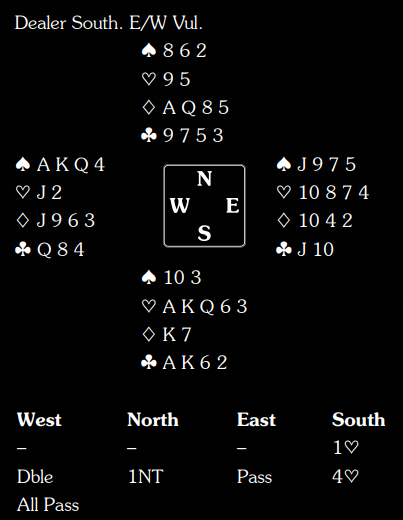
A fairly common play technique is the Coup en Passant. The fancy French name hides a pretty simple technique. Declarer attempts to make her small trumps by leading a side suit through an opponent who has a bigger trump than the one with which declarer hopes to ruff.
Take a look at this example:

South plays in Four Hearts and West leads out the three top spades. Declarer ruffs and cashes the ace, king and queen of trumps. An even break would have provided ten tricks but the four-two break creates a small problem. No matter, declarer continues by
cashing two top clubs then the three diamond winners.
She follows up by leading dummy’s fourth diamond.
Though East has the high trump, there is nothing she can do to prevent declarer from
making her small trump en passant. If East ruffs high, declarer discards and makes his small heart later, while if East discards declarer ruffs the diamond.
Do you see the importance of cashing the top clubs before playing out the diamonds? If declarer fails to do this, East can throw a club on the fourth diamond and is now
in a position to ruff the second club winner, leaving declarer a trick short.
Was there anything the defence could have done to prevent declarer from making the contract?
Yes, but it was tough to see. West has to cash the two spade winners immediately or declarer pitches a loser on the third diamond then plays three rounds of clubs to establish a long card in the suit for her tenth trick. However, the winning defence is to switch at trick three.
Declarer cannot afford to overtake the king of diamonds so has only one dummy entry and needs two to take two ruffs. In the fullness of time, she will lose both a club and a heart.

 A fairly common play technique is the Coup en Passant. The fancy French name hides a pretty simple technique. Declarer attempts to make her small trumps by leading a side suit through an opponent who has a bigger trump than the one with which declarer hopes to ruff.
Take a look at this example:
A fairly common play technique is the Coup en Passant. The fancy French name hides a pretty simple technique. Declarer attempts to make her small trumps by leading a side suit through an opponent who has a bigger trump than the one with which declarer hopes to ruff.
Take a look at this example: South plays in Four Hearts and West leads out the three top spades. Declarer ruffs and cashes the ace, king and queen of trumps. An even break would have provided ten tricks but the four-two break creates a small problem. No matter, declarer continues by
cashing two top clubs then the three diamond winners.
She follows up by leading dummy’s fourth diamond.
Though East has the high trump, there is nothing she can do to prevent declarer from
making her small trump en passant. If East ruffs high, declarer discards and makes his small heart later, while if East discards declarer ruffs the diamond.
Do you see the importance of cashing the top clubs before playing out the diamonds? If declarer fails to do this, East can throw a club on the fourth diamond and is now
in a position to ruff the second club winner, leaving declarer a trick short.
Was there anything the defence could have done to prevent declarer from making the contract?
Yes, but it was tough to see. West has to cash the two spade winners immediately or declarer pitches a loser on the third diamond then plays three rounds of clubs to establish a long card in the suit for her tenth trick. However, the winning defence is to switch at trick three.
Declarer cannot afford to overtake the king of diamonds so has only one dummy entry and needs two to take two ruffs. In the fullness of time, she will lose both a club and a heart.
South plays in Four Hearts and West leads out the three top spades. Declarer ruffs and cashes the ace, king and queen of trumps. An even break would have provided ten tricks but the four-two break creates a small problem. No matter, declarer continues by
cashing two top clubs then the three diamond winners.
She follows up by leading dummy’s fourth diamond.
Though East has the high trump, there is nothing she can do to prevent declarer from
making her small trump en passant. If East ruffs high, declarer discards and makes his small heart later, while if East discards declarer ruffs the diamond.
Do you see the importance of cashing the top clubs before playing out the diamonds? If declarer fails to do this, East can throw a club on the fourth diamond and is now
in a position to ruff the second club winner, leaving declarer a trick short.
Was there anything the defence could have done to prevent declarer from making the contract?
Yes, but it was tough to see. West has to cash the two spade winners immediately or declarer pitches a loser on the third diamond then plays three rounds of clubs to establish a long card in the suit for her tenth trick. However, the winning defence is to switch at trick three.
Declarer cannot afford to overtake the king of diamonds so has only one dummy entry and needs two to take two ruffs. In the fullness of time, she will lose both a club and a heart. 



























